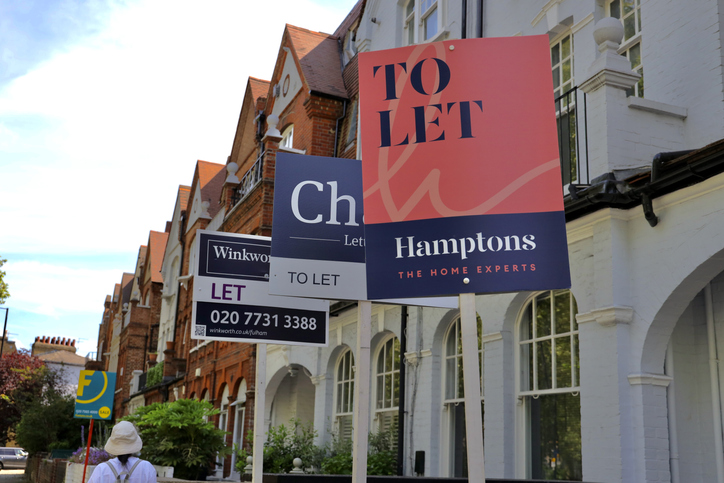Property finance, personalised for success.
Mortgages for Portfolio Landlords
Portfolio landlords face unique needs and challenges. Our service is designed to provide you with comprehensive support and expert guidance, ensuring that you can manage your property investments effectively and make informed financial decisions.
We’re well-versed in the intricacies of managing multiple properties and can offer insights that are specifically tailored to your situation.
Managing a portfolio of properties can be complex, but our streamlined process makes it easier for you to navigate. From assessing your portfolio to finding the right mortgage products, we’ll guide you through each step.
With our extensive network of lenders, we have access to a wide range of mortgage options. This means we can help you find competitive rates and terms that suit your portfolio’s needs.


What is a portfolio landlord?
The Prudential Regulation Authority (PRA) define a portfolio landlord is a person with four or more Buy to Let Mortgaged properties. The properties could be Holiday Lets, HMO’s or Multi-Units owned personally or in a Limited Company, they don’t have to be BTL properties, but BTL is used as a catch all term.
New portfolio landlord rules
In September 2017 the PRA brought in new buy-to-let rules which apply whether the borrower is an individual or a company. The rules state that lenders who offer finance to portfolio landlords are to do so in accordance with a more specialist underwriting process that looks at the overall portfolio as well as the individual property they are financing either by way of a remortgage or purchase.

Mortgages for Portfolio Landlords
The main criteria difference between the choice of lenders for portfolio landlords is how many properties they have. Some lenders state the borrower can have no more than 10 mortgaged properties on completion of their mortgage if a purchase, or no more than 10 from the outset if a remortgage. If you own 11 or more the lender pool reduces a little and options can be less mainstream and more into specialist lending. There are many lenders for many different types of portfolios landlords and there’s not much we haven’t seen in our combined over 20 years’ experience dealing with portfolio landlords.

Financing to expand your portfolio
Suspendisse potenti. Mauris facilisis felis vitae lacinia porta. Vestibulum ac ultricies nibh. Interdum et malesuada fames ac ante ipsum primis in faucibus. Integer interdum risus nec fringilla luctus.
Nullam porttitor ex vitae ex molestie sollicitudin. Nulla facilisi. Vestibulum ut lobortis tellus. Phasellus nulla risus, congue ac leo sit amet, fringilla ultricies arcu. Vestibulum ante ipsum primis in faucibus orci luctus et ultrices posuere cubilia curae.
Portfolio Landlord Mortgage FAQs
A portfolio buy to let mortgage is tailored to investors looking to finance properties for renting to tenants who own four or more mortgaged investment properties.
With portfolio buy to let mortgages you borrow funds to purchase or remortgage properties with the aim of generating rental income. This income covers mortgage payments and potentially leads to profit. Lenders factor in potential rental income and your finances to decide on terms.
Deposits are usually higher, ranging from 20% to 40%. Costs like property maintenance and insurance need to be taken into consideration.
Buy to let offers a chance to build a property portfolio and profit from rent and property value growth. However, research and advice are crucial before diving into property investment.
The amount you can borrow with a portfolio buy to let mortgage depends on several factors, including the potential rental income of the property and your own financial circumstances. Typically, lenders calculate the maximum loan amount based on a rent-to-mortgage ratio, ensuring that the potential rental income is sufficient to cover the mortgage repayments.
As a general guideline, lenders often require the rental income to be around 125% to 165% of the mortgage payments. This means that the monthly rental income should exceed the mortgage payment by a certain margin to account for void periods, maintenance costs, and other expenses.
Additionally, lenders may consider your personal income, credit history, and existing financial commitments when determining how much you can borrow. They may also factor in the type of property you’re investing in and its location.
To get an accurate estimate of how much you can borrow with a portfolio buy to let mortgage, we assess your individual situation and provide you with a clearer picture of your borrowing capacity.
Eligibility criteria for a portfolio buy to let mortgage vary among lenders, but common factors include –
Rental Income: Lenders typically require the potential rental income to cover a certain percentage (125%-165%) of the mortgage payments but this depends on many factors including whether you are a lower or higher rate taxpayer, if you opt for a 2- or 5-year fix product and if it’s a purchase, remortgage or remortgage with capital raise transaction. We are highly experienced in working out all the permutations and providing you with the options to make an informed decision.
Portfolio: Lenders have criteria for the overall loan to value (LTV) and interest coverage ratio (ICR) of an existing portfolio. This forms part of our assessment when we are researching a client’s finance options.
Deposit: A deposit amount of around 20-40% of the property’s value, is usually required. This really does depend on the monthly rent of the property as the maximum loan amount is based on the interest coverage ratio that the monthly rent achieves which in turn determines how much deposit you’d need to put down. This forms part of our assessment when researching your finance options.
Credit History: A good credit history demonstrates your ability to manage debt responsibly.
Affordability: Lenders assess your ability to cover rental voids and property maintenance, considering your personal income, financial commitments and savings.
Property Type: The property’s condition, location, and potential rental demand are factors lenders consider.
Regulations: You need to comply with relevant legal and regulatory requirements for rental properties.
Nationality/Residency: Some lenders have restrictions based on your nationality or residency status.
Remember, each lender’s criteria may differ, so it’s crucial to consult with your mortgage adviser to understand your eligibility before applying.
The required deposit for a portfolio buy-to-let mortgage typically ranges from 20% to 40% of the property’s value. This is higher compared to residential mortgages, where deposits can start at around 5% to 20% of the property’s value.
The specific deposit percentage can vary based on several factors:
Lender’s Policy: Different lenders have varying deposit requirements based on their risk tolerance and lending policies.
Property Type: The type of property you’re investing in can influence the deposit amount. Some lenders might require a higher deposit for certain property types or locations.
Borrower’s Profile: Your financial situation, credit history, and experience as a landlord can also impact the deposit requirement.
Loan Amount: In some cases, the size of the loan you’re applying for might affect the deposit percentage. This is because the monthly rent the property achieves determines the maximum loan amount and if this is lower than expected you would need to put in more deposit to make up the lower loan amount.
Market Conditions: Economic conditions and the lending landscape might influence deposit requirements.
It’s important to note that a higher deposit can lower your loan-to-value (LTV) ratio, which could potentially result in more favourable interest rates and terms. However this means a larger upfront investment on your part.
When considering a Buy-to-Let investment, it’s recommended to consult with mortgage adviser to understand the specific deposit requirement based on your circumstances and the current lending market conditions. We are highly experienced and do not hesitate to give us a call to talk through your plans.
The income requirements for obtaining a portfolio landlord mortgage can vary among lenders and depend on several factors, including the lender’s policies, the size and profitability of your portfolio, your creditworthiness, and the type of properties you own. While there might not be a fixed income requirement, having a stable and sufficient income is typically important for mortgage approval.
Here are some considerations regarding income when applying for a portfolio landlord mortgage –
Rental Income: Rental income generated from your portfolio is a crucial component of your overall income assessment. Lenders will assess whether the rental income is sufficient to cover the mortgage payments, along with other expenses.
Personal Income: Some lenders might also consider your personal income, especially if your rental income is not consistent or if you have void periods. This is to ensure you can cover mortgage payments if rental income decreases.
Affordability: Lenders will perform an affordability assessment to ensure you can comfortably manage your mortgage payments alongside any other financial obligations.
Debt-to-Income Ratio: Lenders often look at your debt-to-income ratio, which is the percentage of your monthly income that goes toward paying debts.
It’s recommended to consult with mortgage advisors or lenders directly to understand their specific income requirements for portfolio landlord mortgages. They can provide you with a clearer understanding of how they evaluate income and affordability for your particular situation. Additionally, working with a mortgage broker experienced in portfolio landlord financing can be valuable, as they can help you identify lenders who are more likely to match your income profile and portfolio size. We are highly experienced and do not hesitate to give us a call to talk through your plans.
Yes, properties owned by a limited company typically count towards your portfolio when it comes to mortgage applications. Lenders generally consider all properties owned by you, whether they are held in your personal name or through a limited company, when assessing your portfolio for mortgage purposes.
If you own properties through a limited company, these properties are often viewed as part of your overall portfolio. However, there might be some differences in how lenders evaluate properties owned by a limited company, particularly when it comes to assessing income and financial stability. Here are a few points to consider –
Rental Income: Lenders will likely assess the rental income generated by properties held in the limited company. They will want to ensure that the rental income is sufficient to cover mortgage payments and other expenses.
Company Financials: If you own properties through a limited company, lenders might also look at the company’s financial performance, including its income, expenses, and profitability.
Debt Service Coverage Ratio (DSCR): For properties owned by a limited company, lenders might use a metric called the Debt Service Coverage Ratio (DSCR) to assess whether the rental income covers the mortgage payments. DSCR compares the property’s net operating income (rental income minus expenses) to the mortgage payment.
Personal Guarantee: In some cases, lenders might require a personal guarantee from the company director(s) when financing properties owned by a limited company. This means that you would personally be responsible for the mortgage payments if the company cannot cover them.
It’s important to communicate clearly with potential lenders or mortgage advisors about properties held within a limited company. They can provide insights into how these properties will be assessed as part of your overall portfolio and what documentation will be required for the mortgage application process.
Buy-to-Let investments, whether you own one or four or more, come with several tax implications in the UK. It’s important to be aware of these considerations to make informed financial decisions. Here are some key tax implications to consider:
Income Tax on Rental Earnings: The rental income you earn from your Buy-to-Let property is subject to income tax. You’ll need to declare this income on your Self-Assessment tax return. Income tax rates vary based on your overall income and tax band.
Wear and Tear Allowance: Previously, there was a Wear and Tear Allowance that allowed landlords to deduct a standard percentage of their rental income for maintenance and repairs. However, this allowance was replaced with a system allowing landlords to claim for actual costs incurred.
Mortgage Interest Tax Relief Changes: Changes have been implemented to mortgage interest tax relief. Instead of deducting mortgage interest from rental income before calculating tax, a basic rate tax credit is now applied. This change has been phased in over several years, and by 2020, the full impact was realised.
Stamp Duty Land Tax (SDLT): When you purchase a Buy-to-Let property, you may need to pay higher rates of Stamp Duty compared to residential properties. Additional SDLT applies to second homes and investment properties.
Capital Gains Tax (CGT): If you sell a Buy-to-Let property and it has appreciated in value, you may be liable to pay Capital Gains Tax on the profit. However, you might be eligible for certain exemptions or reliefs, such as Principal Private Residence Relief, Lettings Relief, and the annual CGT exemption.
Inheritance Tax (IHT): Buy-to-Let properties are typically included in your estate for Inheritance Tax purposes. This means that their value could be subject to IHT upon your passing, depending on the total value of your estate.
These tax implications are subject to change based on government policies and regulations. It’s recommended to consult with a tax professional who specialises in property taxation to ensure you’re fully aware of your tax obligations and can plan your Buy-to-Let investment accordingly.
Applying for a Portfolio Buy to Let mortgage involves several steps that are similar to applying for other types of mortgages. Here’s a general overview of the process:
- Initial Chat
Discuss your plans: Give us a call or email us to schedule a call to initially talk through your plans and what you are looking to do. - Documentation Gathering:
Prepare documents: Once we’ve had a discussion and what you are looking to do seems feasible and we’ve provided an idea of product interest rates, we will email you our documents to complete and a list of documents to provide. - Research and Preparation:
Research lenders: Once we have received our completed documents and requested documents, we will research lenders that offer portfolio buy to let mortgages and provide you with the cheapest product options you and the property are eligible for. - Decision in Principle and Mortgage Application:
Once a product has been selected e.g. a 2- or 5-year fix product, we will submit the Decision in Principle and Mortgage Application. - Underwriting and Approval:
Underwriting process: The lender’s underwriting team will assess your application and verify the provided information. - Property Valuation:
Valuation assessment: The lenders will value the property and assess its suitability considering factors like location, size and condition. - Rental Income Valuation:
Rental assessment: The lender will also value the projected rental income of the Buy to Let property, considering the condition of the property, local rental market, and other factors. - Offer and Terms:
Mortgage offer: If your application is approved, the lender will provide a formal mortgage offer outlining the terms, conditions, interest rates, and fees. - Legal and Regulatory Checks:
Legal and regulatory review: Your solicitor or conveyancer will review the property’s legal title, ensuring there are no issues that could affect the mortgage or property ownership. - Completion:
Legal: Your solicitor will coordinate the completion process. It’s important to note that the process can vary depending on the lender, your location, and individual circumstances. Working with a knowledgeable mortgage broker can streamline the process, ensure you meet all requirements, and help you find the best Portfolio Buy to Let mortgage for your investment goals.
We are highly experienced and do not hesitate to give us a call to talk through your plans.
Reviews Don’t Lie
Don’t take our word for it – check out our amazing reviews on Google!